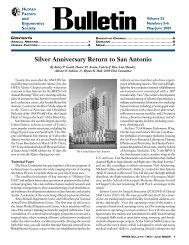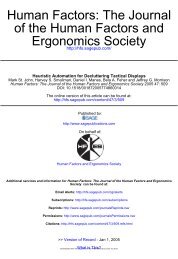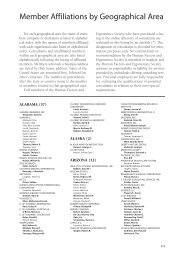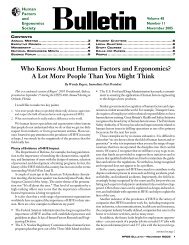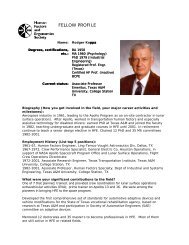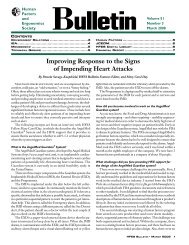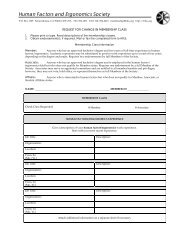Next Generation Air Transportation System Integrated Plan
Next Generation Air Transportation System Integrated Plan
Next Generation Air Transportation System Integrated Plan
Create successful ePaper yourself
Turn your PDF publications into a flip-book with our unique Google optimized e-Paper software.
This environmental compatibility will be achieved through<br />
a combination of improvements in aircraft performance and<br />
operational procedures, land use around airports, policies and<br />
incentives to accelerate technology introduction into the fleet,<br />
and aircraft de-icing procedures. The <strong>Next</strong> <strong>Generation</strong> <strong>Air</strong><br />
<strong>Transportation</strong> <strong>System</strong> (NGATS) will apply advances in design,<br />
engineering, and emerging technologies to ensure that growth<br />
in the number of aircraft and airports does not exceed approved<br />
environmental limits. Further gains will be realized from new<br />
policies and approaches in regulation and mitigation. Long-term,<br />
reinvigorated research and development and refined technology<br />
implementation strategies will help to keep pace with changing<br />
environmental requirements.<br />
Policy and financial incentives will be used to accelerate the<br />
introduction of environmental technology improvements in aircraft,<br />
including propulsion technologies, materials development, and<br />
airframe designs. Intelligent flight planning, coupled with improved<br />
flight management capabilities, will enable more fuel-efficient<br />
profiles throughout the flight envelope. Noise and local emission<br />
reduction efforts will be coordinated among multiple aviation<br />
operations in large metropolitan areas.<br />
By 2025, the impact of aviation on community noise and local air<br />
quality will be reduced in absolute terms, even with anticipated<br />
growth in air traffic. Uncertainty in the emerging issues of climate<br />
change and health effects of emissions will be reduced to a level that<br />
enables appropriate actions to be undertaken to address these effects.<br />
<strong>Air</strong>ports will be valued neighbors keeping the public well informed<br />
about aviation and environment issues. <strong>Air</strong>lines and airframe/<br />
engine manufacturers will be recognized as global leaders in jointly<br />
addressing mobility and environmental needs.<br />
Objectives<br />
• Reduce noise, emissions, and fuel consumption<br />
• Balance aviation’s environmental impact with other societal<br />
objectives<br />
obtaining a common picture of our skies will enable a proactive<br />
approach to protection. It also will facilitate rapid responses to a variety<br />
of threats. For example, improved information regarding aircraft that<br />
may be entering restricted airspace will likely reduce the need for<br />
combat air patrols.<br />
The future air transportation system also will improve support for<br />
military missions. Commercial carriers will be able to provide more<br />
capable and economical transportation services and access to global<br />
airspace. Additionally, global harmonization of standards, procedures,<br />
and operations will reduce the investment necessary to ensure U.S.<br />
military access to international airspace.<br />
The availability of improved tracking and surveillance technologies will<br />
allow continued commercial and civilian access to our national airspace<br />
while mobilizing defense activities. The future system will feature the<br />
ability to define flexible airspace, quickly changing boundaries required<br />
by military and civilian operations. This will enhance the ability to<br />
support military missions and ensure continuous quality service to<br />
other airspace users.<br />
Objectives<br />
• Provide for the common defense while minimizing civilian<br />
constraints<br />
• Coordinate a national response to threats<br />
• Ensure global access to civilian airspace<br />
3.6 Secure the Nation<br />
In light of the continuing threat of terrorism, new defense tactics<br />
and technologies must be put in place without compromising<br />
efficiency. These measures must address a wider range of threats,<br />
while at the same time lowering the cost and impact of these<br />
measures on pilots and the traveling public.<br />
3.5 Ensure Our National Defense<br />
The future air transportation system must be able to facilitate the<br />
nation’s ability to respond rapidly to emerging threats while maintaining<br />
commercial and civilian access to our airspace. Integrating the<br />
information and communication systems of defense agencies is essential<br />
to ensuring that our nation is prepared to combat threats.<br />
<strong>Integrated</strong> capabilities will support national defense by improving<br />
our ability to share information among agencies and organizations<br />
responsible for protecting our country. Sharing information and<br />
Joint <strong>Plan</strong>ning & Development Office 09




